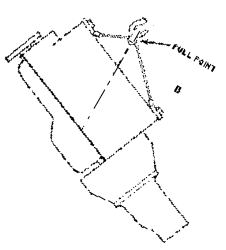ENGINE REMOVAL
GETTING STARTED
GETTING STARTED
There are many different types of engines and cars so not one procedure is the exact way to do it for all models but this will give a good out line of what to do.
| OK ,raise the hood and cover the fenders with a blanket or pad . So you don't scratch or
get oil or grease etc. on them. You have to remove the hood but, before you do that take something to scribe around the hood hinge. This will help you align the hood when you replace it. See Fig. 1 Remove the hinge bolts, lift the hood off and store upright in a PROTECTED area.
Drain the cooling system and remove the hoses and the radiator. Handle the radiator carefully
and put it also in a
PROTECTED area. |
 |
Disconnect coil wires, starter and alternater wires, oil pressure and temperature
As wires are removed, they should be marked in some manner so you know where they belong
when you go to put them back on.
One good way is to wrap a peice of masking tape around it and write on the tape what it is.
See Fig. 2

indicator wires, engine ground strap and any other accessory wires.
Disconnect gas line from the gas tank to fuel pump, vacuum lines, oil pressure ( if used ) and any other line that is attached to the engine.
Remove the air cleaner and cover the carburetor with a plastic bag, so no dirt will get in there.
Disconnect carburetor linkage and transmission linkage and clutch linkage (if you have one ) and any other transmission rods (if the transmission is to be pulled with the engine) .
Disconnect exhaust pipe at exhaust manifold.
Remove the fan too. Also take the bolts out of the motor mounts and transmission mounts.
Drain the engine and transmission oil. Remove the oil filter. On automatic transmissins remove the oil cooler lines and tape the ends so dirt can't get in. (you will have to do this at the radiator too. )
Remove any support brackets attached to the engine or transmission.
Chech to make sure all necessary items have been removed.
It's a good practice once the part has been removed to put the bolts back in the place where they came out of and to mark wires where they go etc. This way you won't lose them and it will speed up reassembly.
When pulling tubing ,hoses,etc. out of the way be sure not to kink them or damage them.
Cover the ends of tubing and hoses with tape to prevent dirt from getting in.
![]()
Get your engine hoist in place and bolt the puller chain or cable to the engine via head bolts. As you are lifting the engine make sure it has clearance on both sides in the back and of coarse that your hoist has top clearance.
As you start lifting pull the engine forward as to break it free from the transmission.
(when the transmission is to be left in the car.)
| When removing the transmission with the engine it will often have to assume a very
steep angle as shown in Fig. 3 in order for it clear everything. As you lift the engine higher anf higher give the engine a gentle rock to make sure it's free of everything. If it stops check for it to be caught on something. Raise high enough to clear the car and emmediately lower to just clearing the floor. You should clean the engine with degreaser and water or a steam genny. After you have the engine clean put it on a good engine stand. That's it . You should have no trouble removing an engine if you follow these easy steps. |
 |